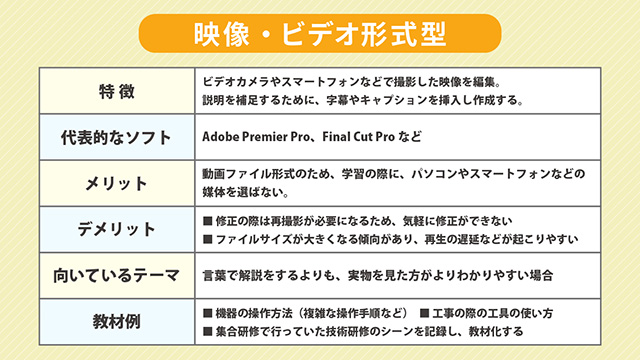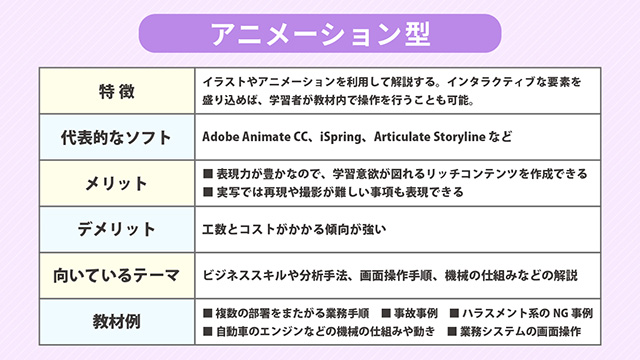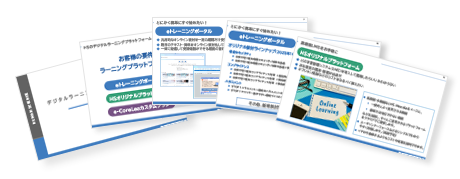2023.09.20
Introducing the points and benefits of creating e-learning videos by type

Combining e-learning and video materials is one of the most effective ways to achieve higher learning outcomes.
The compatibility between interactive e-learning and video materials, which allow for intuitive understanding of abundant information, is excellent and contributes to increasing learners' motivation and comprehension.
In this blog, we will explore the appeal of video materials from a multifaceted perspective, including the benefits of using video materials, types of materials, and points to keep in mind when creating them. We would like to delve into the potential of "e-learning x video materials".
※The term "video" in this blog refers to not only live-action, but also all types of moving images such as motion graphics and slideshows.
Table of Contents
1. Background of the widespread use of video materials in e-learning
2. Benefits of using video materials
3. Genres where learning effects can be expected with video materials
4. There are three main types of video materials
5. Points to consider when creating video materials for e-learning
6. Conclusion
1. Background of the widespread use of video materials in e-learning
The background behind the use of video materials in e-learning is influenced by various factors. Here are some of the main ones listed below.

(1) Internet Speed Increase
With the widespread availability of high-speed internet, it has become possible to stream high-quality videos. This has created an environment where video materials can be effectively provided on e-learning platforms.
(2) Spread of mobile devices such as smartphones
With the spread of smartphones and other mobile devices, it has become possible to learn anytime, anywhere, regardless of time or location. Video materials can be easily accessed on various mobile devices, making it possible to cater to a wide range of learning styles and increasing demand.
(3) "Video viewing" has become a habit for people
With the high-speed internet and widespread use of mobile devices, watching videos on platforms like YouTube, Netflix, and social media has become a habit for people, making videos an essential part of their daily lives. As a result, the act of "learning through videos" has become widely accepted and has led to the spread and expansion of video materials, as they are able to capture people's interest and attention.
(4) Increase in video material creation tools
With the demand for e-learning and the advancement of technology, there has been an increase in tools that allow for easy creation of video materials within LMS (Learning Management System), such as built-in tools and screen capture software. As a result, video materials are now being utilized in various fields.
As a result of these factors, video materials have become increasingly common in e-learning. "Learning through videos" is considered to be a powerful tool for increasing motivation in learning, and its importance is expected to continue to grow in the future.
2. Benefits of Using Video Materials
With the rise of the "video culture" in modern times, video materials have become widely used in many companies and educational institutions. Furthermore, the popularity of video materials can be attributed to the various benefits they offer. In this chapter, we will explain the advantages of using video materials.

(Benefit 1) Improved Learning Effect through Visual Information Transmission
Videos that combine images and sound can convey information visually and auditorily. Visual information, in particular, is easy to remember and can deepen understanding, making it possible to expect an improvement in learning effectiveness.
(Benefits.2) Complex information can also be conveyed clearly
By explaining abstract concepts and complex processes through videos, they can be understood more easily. By using live-action or animation and providing specific examples, it is possible to improve the retention and understanding of information.
(Benefit 3) Attracts Learner's Interest
Video materials with visual appeal can attract learners' interest even more by incorporating movement and production. As a result, learning becomes more enjoyable, leading to increased motivation for learning.
(Benefit 4) Interactive Elements Can Be Incorporated
Video materials can incorporate interactive elements such as quizzes and surveys. By actively engaging learners and confirming their current level of understanding, more effective learning becomes possible.
(Benefit 5) Can provide a flexible learning environment
By using smartphones or tablets, learners can access video materials anytime, anywhere, allowing them to learn at their own pace. It also provides opportunities for learners to engage in learning during spare time such as commuting or waiting, giving them a sense of "killing time" while learning.
(Benefits.6) Easy to Modify and Update Content
Video materials are in digital format, making it relatively easy to redistribute after modification or update. You can always keep the materials up to date with the latest information and trends.
(Benefits.7) Maintaining Consistency
All learners watch and learn from the same video materials. This means that the quality and content of learning can be standardized.
From these benefits, it has been found that video materials are an effective educational method in e-learning. There are high expectations for video materials to contribute to improving the quality and effectiveness of learning, and to achieve efficient and effective learning.
3. Genres with expected learning effects through video materials

This is a video teaching material with various benefits, but what kind of genre is it effective for learning? We have summarized the learning genres that can particularly expect learning effects.
■ Demonstration and Operation Explanation
When learning how to use a product or software, video materials are particularly effective. By visually displaying complex information such as operating procedures and function explanations, learners can easily understand the actual steps.
■ Language Learning
By demonstrating various examples of pronunciation and conversation in video materials, learners can intuitively acquire correct pronunciation and gestures, and improve their listening and speaking skills.
■ Physical Movement Training
Videos are also effective when learning physical movements such as sports, fitness, art, and cooking procedures. By showing the actual movements in a video, learners can practice while imitating the video.
■ Technical Skills
When learning practical technical skills such as programming and design, video materials can be helpful. Complex technical content that may be difficult to understand through words alone can become easier to understand by watching demonstration and performance videos.
■ Learning Complex Knowledge
When learning specialized knowledge or abstract concepts, it can be difficult to understand information through text alone. Visual aids such as animations and graphics can make it easier for learners to grasp the information. Video materials using these elements can help facilitate understanding for learners.
■ On-site training and field work
When conducting on-site training and field work, video materials can serve as effective supplementary tools. By utilizing video materials beforehand to acquire basic knowledge, understanding in the field will deepen and lead to efficient learning.
Video materials that promote visual understanding are widely used in various educational fields, as the saying goes, "seeing is believing." They allow for learning by showing the actual material without the need for extensive explanations.
4. There are three types of video materials.
When classifying video materials, there are three main types. Each type has its own advantages and disadvantages, and is suitable for different subjects.
Let's check the characteristics of each type.
〈Type 1. Document Type〉
The "Document Type" is a method of utilizing PowerPoint or PDF documents as video materials. It is relatively quick to create and distribute the materials, allowing for cost savings. Therefore, it is suitable for materials that require frequent updates or for quickly sharing important information.

※Learn how to create instructional materials for data types on this page.
〈Type 2. Video Format Type〉
"Video Format Type" is a type of video material that is created by adding subtitles and captions to videos taken with a video camera or smartphone, and using them as supplementary explanations. A typical example is recording a lecture by a teacher and distributing it as a teaching material. One of the attractive points is that it can be learned without being limited to media such as computers and smartphones, as it is in video file format.

※How to create video and video format type teaching materials is explained in detail on this page.
Type 3. Video and Animation Type
The "animation type" uses characters and illustrations to explain, and can effectively showcase abstract concepts, corporate values, and difficult-to-reproduce events or case studies. It also allows for interactive elements such as quizzes and simulations for learners to engage with within the material.

5. Points to Consider When Creating Video Materials for e-Learning

If you have read this far, you may have been touched by the appeal of video materials and may want to try making them yourself. When creating video materials, it is necessary to keep in mind some key points. Let's consider the following points and create high-quality video materials.
(Point 1) Clearly Define Your Target Audience
Video materials are directly viewed by individual learners, so it is important to understand the needs and level of your target audience. Consider their background, prior knowledge, learning style, etc. and design the content and language accordingly.
(Point 2) Short and Simple Content
Long videos have the potential to disrupt the concentration of learners, so it is effective to have short and easy-to-understand video materials. It is important to not cram too much information into one video, clearly highlight important points, and provide content without any unnecessary elements.
(Point 3) Pay attention to design and audio
Let's also consider the design of the video. It is important to incorporate graphs, diagrams, animations, etc. effectively to visually complement the content. Also, pay attention to the quality of the audio and video, and be conscious of creating effective learning experiences.
(Point 4) Add Interactive Elements
By adding interactive elements to video materials, it can increase learners' motivation and also promote the retention of learning. It is also recommended to insert participatory content such as quizzes, exercises, and surveys to provide learners with opportunities to "confirm their understanding".
(Point 5) Mobile Compatibility
As many people use their free time or time while on the move to study, it is important to ensure that video materials can be comfortably viewed on mobile devices. Pay attention to screen size and responsive design, and provide a comfortable learning environment for learners.
(Point 6) Prepare a variety of variations
It can be difficult to attract the interest and sustain the concentration of learners with monotonous video materials. For example, why not try preparing a variety of content by incorporating scenarios and storytelling? With "captivating" content, learners will be able to continue learning with enthusiasm and persistence without getting bored.
(Point 7) Review and Test for High-Quality Video Materials
After completing the production of video materials, it is important to conduct a review and test to ensure that there are no defects or errors. It is also important to have various people watch the video and incorporate their feedback to make necessary revisions. By repeating this process, it becomes possible to provide high-quality video materials.
When creating video learning materials in e-learning, it is important to take the perspective of the learner and strive for quality and clarity of content. By creating with consideration and ingenuity, we can provide an effective learning experience and maximize the achievements of the learners.
6. Summary
Using video materials in e-learning plays an important role in enhancing learners' understanding and interest. However, while video materials are useful for improving visual understanding, it is also important to maintain a balance in learning and combine various materials to achieve more effective learning.
At Human Science, we have a wealth of experience in creating e-learning materials. We utilize our project management expertise to support the planning and design of e-learning. Each project is assigned an experienced project manager and a dedicated team of consultants to provide support until delivery. If you have any concerns about creating learning materials, please feel free to consult with us.
Please see below for each service.
> Moodle Implementation Support and Operation
> e-Learning Material Creation
> e-Learning Material Translation (Multilingual Support, Localization)
Latest Blog
- 04/02/2024
- English Learning Using Moodle and ChatGPT












